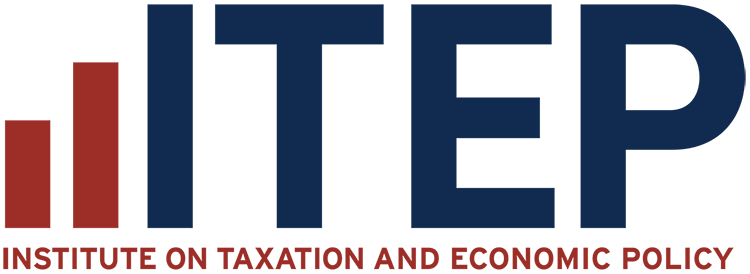
ITEP Work in Action
Idaho Center for Fiscal Policy: Analysis of House Bill 463
February 6, 2018
One motivation for reducing taxes this year is to offset the increase in revenue that conformity – aligning our state tax code with recent federal changes – will bring. If Idaho chooses to conform, the state will collect additional revenue in the range of $82 million to $97.4 million. This means that some Idahoans – particularly those with multiple children - will pay more in state taxes.
Georgia Budget and Policy Institute: Immigrants Make Georgia Stronger and Better Every Day
February 1, 2018
Immigrant taxpayers contribute to Georgia’s bottom line. As immigrants start businesses, buy homes, earn wages and spend disposable income at local businesses, they generate considerable state and local tax revenue regardless of citizenship status. Undocumented Georgians contributed an estimated $352 million in state and local taxes in 2014, according to the Institute on Taxation and […]
Georgia Budget & Policy Institute: People-Powered Prosperity
February 1, 2018
People-Powered Prosperity details a new vision for how state lawmakers can pursue strategies to help all Georgians thrive, as well as how the state can responsibly pay for it.
Colorado Fiscal Institute: Effect of Federal Tax Law on Revenue for Colorado and Colorado Taxpayers
January 31, 2018
The Colorado Fiscal Institute (CFI) has a long-time partnership with the Institute of Taxation and Economic Policy (ITEP) and their estimate of the impact on state revenue is significantly smaller than the current amounts predicted by the Colorado Legislature and the Colorado Governor’s Office. This brief explains the various components of the ITEP estimate.
Here’s Why Arkansas Needs a State EITC
January 31, 2018
Arkansas is part of a shrinking group of states that haven’t started using tax credits, like the Earned Income Tax Credit (EITC), to build their middle class and help people move permanently out of poverty. Arkansas remains among the worst states for overtaxing the poor.
Economic Progress Institute: Budget Matters: Making Rhode Island’s Tax Structure More Equitable and Adequate
January 30, 2018
For Rhode Island to achieve its potential as a first-class place to live and do business we need to ensure that we have the public services and amenities that enhance the quality of life and work in our state. Rhode Islanders make a collective investment through taxes, fees, and other forms of revenue to fund the services that businesses and residents count on.
Colorado Fiscal Institute: Colorado State Tax Basics
January 29, 2018
The Colorado Fiscal Institute (CFI) promotes tax and budget policies that are effective, efficient, equitable, transparent and accountable. Each year, CFI takes positions on new legislation that affects the sustainability and equity in Colorado's state budget and tax system.
Third and State: Fact Check: Undocumented Immigrants like the Dreamers are not a Drag on State and Local Governments
January 27, 2018
A recent study by the Institute on Tax and Economic Policy (ITEP) shows that the estimated 137,000 undocumented immigrants in Pennsylvania pay our state and local governments almost $135 million in taxes each year. (They pay $11.7 billion in state and local taxes nationwide.) Read more here
Michigan League for Public Policy: The EITC: The Good, The Great And The Unfortunate
January 26, 2018
According to modeling by the Institute on Taxation and Economic Policy, in 2019 about 1,400 fewer filers (about 0.4%) will qualify for the credit, resulting in $7 million in fewer federal credits being distributed to the state. By 2027 about 14,500 fewer filers (about 2%) will qualify for the credit, resulting in a loss of $96 million of federal credit value. The same filers who lose their federal EITC will also lose their ability to claim their state EITC, resulting in a loss of additional local economic support.
NJPP: A Grain of ‘SALT’: New Jersey Needs More Than Workarounds to Respond to GOP Tax Plan
January 25, 2018
That’s because these workarounds would disproportionately benefit the wealthiest households in New Jersey, to make no mention of the fact that the Trump administration is unlikely to allow them to stand.
DCFPI: As High-Income DC Taxpayers Reap Large Federal Tax Windfalls, DC Can Make Our Tax Code More Progressive
January 22, 2018
According to recent estimates from the Institute for Taxation and Economic Policy (ITEP), District of Columbia residents can expect to receive an $850 million federal tax break this year.
MassBudget: What Does the Federal Tax Law Mean for Massachusetts and How Might the Commonwealth Respond?
January 22, 2018
The tax cuts are also skewed toward high-income tax filers when measured as a portion of their own incomes.
Pennsylvania Budget and Policy Center: The Pennsylvania Promise: Making College Affordable and Securing Pennsylvania’s Economic Future
January 22, 2018
Three recent briefs by the Keystone Research Center laid out the case for more affordable access to post-secondary education in Pennsylvania. The global race for raising incomes and increasing opportunity hinges critically on access to post-secondary education and training. If Pennsylvania does not expand access to higher education to more of its citizens, the Commonwealth’s economy will suffer and living standards will lag behind growth elsewhere. With a modest and smart investment, Pennsylvania can build a more prosperous future for its citizens and reinvigorate the American Dream in every corner of the keystone state. “The Pennsylvania Promise,” outlined below, shows…
MassBudget: Sweeter than SALT: Highest-Income Households Get Federal Tax Cuts More Than Twice SALT Losses
January 11, 2018
For Massachusetts’ highest-income households – those with annual incomes over $1 million – the average tax cuts from other federal changes in the law are more than twice the average size of the impact from the loss of SALT deductibility.
It’s All About the Context: A Closer Look at Arkansas’s Income Tax
January 10, 2018
The tax task force is rounding out its extensive review of the Arkansas tax code this week by looking at one of the most contentious tax topics these days: income taxes. So, are we a high-income-tax state or a low-income-tax state? In Arkansas, it depends a lot on how much money you make, and how you make it. For example, retirement income is exempt for the first $6,000; military retirement income is completely exempt; there are border-city exemptions if you work in Texarkana; and capital gains income from things like stocks or real estate sales is taxed much more leniently…
Kentucky Center for Economic Policy: Passage of the Dream Act Would Benefit Kentucky
December 21, 2017
The Institute on Taxation and Economic Policy (ITEP) estimates that 6,000 (formerly) DACA-eligible Kentuckians currently contribute a total of $8.1 million in local and state taxes annually through sales and excise taxes, property taxes and income taxes. Their effective tax rate of 9.1 percent is higher than that paid by the wealthiest 1 percent of […]
Policy Matters Ohio: Crackdown on Dreamers could cost Ohio millions
December 21, 2017
If DACA recipients stay in Ohio after losing work authorization they could earn lower wages and become less likely to file income tax returns. Without the Dream Act, Ohio can expect to lose at least $5 million in tax revenue, according to the Institute on Taxation and Economic Policy (ITEP). Read more here
Wisconsin Budget Project: Giving Young Immigrants a Pathway to Citizenship Would Boost Wisconsin’s Farm Economy
December 20, 2017
According to a new report from the Wisconsin Budget Project, passing the Dream Act and establishing a pathway to citizenship for immigrant youth would help Wisconsin farms and communities by: Expanding Wisconsin’s economy by up to $600 million a year by improving the access that immigrants have to educational and economic opportunity; Increasing state and […]
Wisconsin Budget Project: Dream Act Would Boost Wisconsin Economy and Tax Revenues: Revoking DACA Hurts Both
December 20, 2017
There are 10,000 young immigrants potentially eligible for DACA who call Wisconsin home. They currently contribute a total of $16 million to local and state taxes annually through sales and excise taxes, property taxes, and income tax. Read more here
Michigan League for Public Policy: The benefits of Deferred Action for Childhood Arrivals (DACA) on immigrants in Michigan
December 20, 2017
Researchers at the Institute on Taxation and Economic Policy (ITEP) estimate that nationwide, DACA enrollees contribute $2 billion in state and local taxes each year. In Michigan, these young adults contribute $13 million in state and local taxes annually. If federal elected officials fail to pass a replacement to DACA and beneficiaries’ work permits expire, […]
New Jersey Policy Perspectives: Failure to Act on DACA and Dream Act Would Harm New Jersey’s Tax Revenues
December 20, 2017
There are 53,000 young immigrants who were potentially eligible for DACA that call New Jersey home. They have attended our public schools, graduated high school and many have enrolled in our public colleges. And many are our coworkers, our neighbors and loved ones. They currently pay a total of $57 million to state and local […]
Florida Policy Institute: Dream Act: What’s at Stake for Florida?
December 20, 2017
There are 72,000 young immigrants who were potentially eligible for DACA that call Florida home. They currently contribute a total of $78 million to local and state taxes annually through sales and excise taxes, property taxes and income tax. Read more here
The Commonwealth Institute: Dream Act Would Boost Virginia Families, Communities, State Economy, and Tax Revenues; Revoking DACA Hurts All
December 20, 2017
There are 30,000 young immigrants who were potentially eligible for DACA and call Virginia home. They currently contribute a total of $29.3 million to local and state taxes annually through sales and excise taxes, property taxes and income tax. Read more here
NC Policy Watch: Devastating consequences if Congress fails to replace DACA in three months
December 20, 2017
State and local government coffers would also take a hit if Congress fails to pass the Dream Act, or another effective solution. The Institute for Taxation and Economic Policy estimates that current DACA recipients pay almost $58 million in state and local taxes, contributions which could grow to $78 million if the Dream Act were […]
Center for Public Policy Priorities: The National Dream Act: What’s at stake for Texas?
December 18, 2017
Researchers estimate that approximately 177,000 young Texas immigrants are potentially eligible for DACA, and they currently contribute a total of $241 million to local and state taxes annually through sales and excise taxes, property taxes and income tax. Without the national Dream Act, Texas can expect to lose at least $79 million in state and […]
Advocates and policymakers at the state and federal levels rely on ITEP’s analytic capabilities to inform their debates on proposed tax policy changes. In any given year, ITEP fields requests for analyses of policies in 25 or more states. ITEP also works with national partners to provide analyses of federal tax policy proposals. This section highlights reports that use ITEP analyses to make a compelling case for progressive tax reforms.
